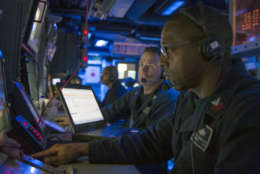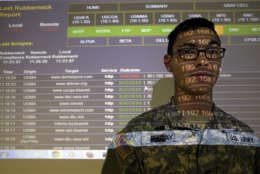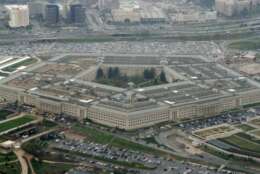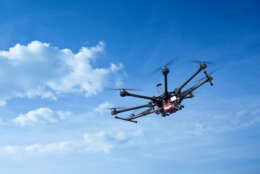Defense
-
The Navy sees a not-too-distant future in which sailors aboard ships have the same level of connectivity they have on shore, thanks almost entirely to advances in the commercial sector.
October 27, 2023 -
Gabe Camarillo, the undersecretary of the Army, said to create a culture of continuous improvement, the Army needs to institutionalize how it buys, develops and continually improve its applications.
October 26, 2023 -
U.S. officials say the number of suicides among military members and their families dipped slightly in 2022, compared with the previous year. This decline comes as the Defense Department tries to build prevention and treatment programs to address what's been a steadily growing problem over the past decade.
October 26, 2023 -
Widening military conflicts around the world have military planners in the U.S. on edge. For some perspective on resiliency, innovation and artificial intelligence in the Defense domain, the Federal Drive with Tom Temin visited the AUSA Conference in Washington earlier this month and spoke with former DoD and Navy chief information officer (and Army veteran) Terry Halvorsen, now with IBM.
October 26, 2023 -
“DoD is deeply committed to building domestic capacity and capability and growing our economy, creating U.S. jobs and strengthening our national security,” said Justin McFarlin, deputy assistant secretary of defense for industrial base development and international engagement, at ComDef23, ahead of the release of the first defense industrial strategy.
October 26, 2023 -
Federal facilities in three more states will be able to buy carbon free electricity as the government expands the availability of this energy to its facilities to achieve its sustainability goals and propel this type of clean energy.
October 25, 2023 -
For the first time since the program's launch in 2018, the number of BRS participants surpassed the number of participants in the military’s legacy retirement system.
October 24, 2023 -
Randy Resnick is the director of Zero Trust Architecture Program Management Office in the DoD’s CIO’s office. A team of 17 to 18 people will analyze the zero trust plans submitted by 43 services and agencies.
October 24, 2023 -
Using artificial intelligence, analysts at Govini have build a digital twin of the U.S. industrial base. It is a disturbing picture. Govini's analysis shows how far behind the United States military is in bringing new technology to bear.
October 24, 2023 -
Only 30% of military personnel transitioning to civilian life start the mandatory transition assistance program on time, a concern for senators who agreed on the importance of the program to help veterans and those transitioning to civilian life.
October 24, 2023 -
A book by a historian from the Naval History and Heritage Command recalls a bizarre episode from a long-ago war. In the great WWII battle for Okinawa, Japan resorted to suicide missions known as kamikaze. The book's title says it all, "On The Verge Of Breaking Down Completely, Surviving The Kamikaze Off Okinawa, 1945. To talk about the book, the Federal Drive with Tom Temin was joined in studio by author Guy Nasuti.
October 23, 2023 -
Unmanned aerial vehicles (UAVs) have been around since the 1960s. What’s next, according to Mark Valentine, the president for global government at UAV maker Skydio: UAV’s that communicate among one another for greater effectiveness, but requiring less routine human input.
October 23, 2023 -
In this exclusive webinar edition of On DoD, our guests will discuss 5G and technology insights at NAVWAR.
October 23, 2023 -
Coast Guard Commandant Linda Fagan said that service’s people are its most valuable asset, so it must take care of them.
October 20, 2023 -
John Weiler, the executive director and co-founder of the IT Acquisition Advisory Council, calls for agencies to be more aggressive in preventing suppliers from advising on IT projects and then developing the system.
October 20, 2023
















